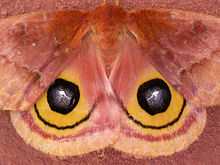Automeris io
| Io moth | |
|---|---|
 | |
| Female (top) and male (below) | |
| Scientific classification | |
| Kingdom: | Animalia |
| Phylum: | Arthropoda |
| Class: | Insecta |
| Order: | Lepidoptera |
| Family: | Saturniidae |
| Genus: | Automeris |
| Species: | A. io |
| Binomial name | |
| Automeris io (Fabricius, 1775) | |
The Io Moth (Automeris io) is a very colorful North American moth in the Saturniidae family. It ranges from the southeast corner of Manitoba and in the southern extremes of Ontario, Quebec, and New Brunswick in Canada, and in the US it is found from Montana, North Dakota, South Dakota, Nebraska, Colorado, New Mexico, Texas, Utah, east of those states and down to the southern end of Florida.[1]
Adult description
Imagines (sexually mature, reproductive stage) have a wingspan of 2.5-3.5 inches (63–88 mm). This species is sexually dimorphic, males having bright yellow forewings, body, and legs, while females have reddish brown forewings, body, and legs. The males also have much bigger plumose (feathery) antennae than the females. Both have one big black to bluish eyespot with some white in the center, on each hindwing, a defense mechanism meant to frighten off potential predators, especially when the moth is sitting in the head-down position.
Life cycle


Females lay small, white ova in the leaves of host plants, including, but not limited to:
- Prunus pensylvanica — Pin cherry
- Salix — Willow
- Abies balsamea — Balsam fir
- Acer rubrum — Red maple
- Amorpha fruticosa — Bastard indigo
- Baptisia tinctoria — Wild indigo
- Carpinus caroliniana — American hornbeam
- Celtis laevigata — Sugarberry or Southern Hackberry
- Cephalanthus occidentalis - Button-bush
- Cercis canadensis — Eastern Redbud
- Chamaecrista fasciculata — Showy Partridge Pea
- Comptonia peregrina — Sweetfern
- Cornus florida — Flowering dogwood
- Corylus avellana — Common hazel
- Fagus — Beech
- Fraxinus — Ash
- Liquidambar styraciflua - American Sweetgum
- Quercus - Oak
The eggs have large micropyle rosettes that turn black as the fertile eggs develop. They are usually laid in clusters of more than twenty. From the eggs, orange larvae emerge, usually eating their egg shell soon after hatching. They go through 5 instars, each one being a little different.
The caterpillars are gregarious in all their instars, many times traveling in single file processions all over the food plant. As the larvae develop, they will lose their orange color and will turn bright green and urticating, having many spines. These stinging spines have a very painful venom that is released with the slightest touch; a condition known as erucism. The green caterpillars have two lateral stripes, the upper one being bright red and the lower one being white. When the caterpillars are ready, they spin a flimsy, valveless cocoon made from a dark, coarse silk. Some larvae will crawl to the base of the tree and make their cocoons amongst leaf litter on the ground, while others will use living leaves to wrap their cocoons with. The leaves will turn brown and fall to the ground during autumn, taking the cocoons with them. There they pupate, the pupa being dark brown/black. The pupae of the females are considerably larger than those of the males.
Adult moths normally emerge from their cocoons in late morning or early afternoon. Eclosion (emergence from the cocoon) only takes a few minutes. After eclosing, the moths climb and hang on plants so that their furled wings can be inflated with fluid (hemolymph) pumped from the body. This inflation process takes about twenty minutes.
Adult moths are strictly nocturnal, flying generally only during the first few hours of the night (Fullard & Napoleone 2001). The females generally wait until nightfall and then extend a scent gland from the posterior region of the abdomen, in order attract males via wind-borne pheromones. The males use their much bigger antennae to track down the females. After mating, the females lay eggs then wait to die. These moths, like all moths in the Saturniidae family, have vestigial mouthparts and do not eat in the adult form.

See also
- Inachis io, a butterfly species.
References
- ↑ "Species Detail | Butterflies and Moths of North America". Butterfliesandmoths.org. Retrieved 2011-10-18.
- Fullard, James H. & Napoleone, Nadia (2001): Diel flight periodicity and the evolution of auditory defences in the Macrolepidoptera. Animal Behaviour 62(2): 349–368. doi:10.1006/anbe.2001.1753 PDF fulltext
External links
| Wikimedia Commons has media related to Automeris io. |
| Wikispecies has information related to: Automeris io |
- Site with a description and pictures
- io moth on the UF / IFAS Featured Creatures Web site